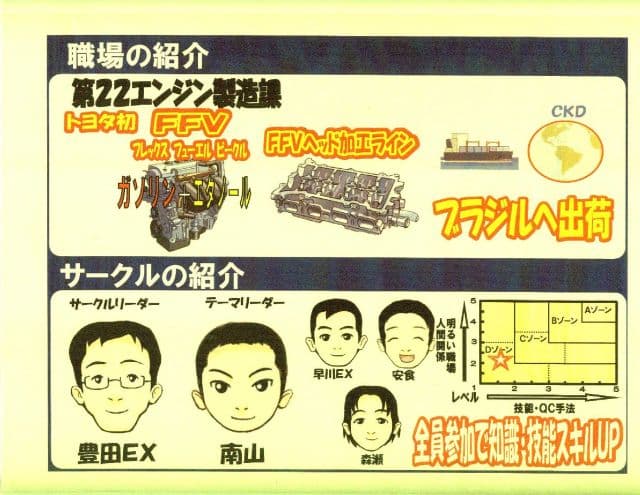An Award-Winning QC Circle Report from Toyota
This is an authentic Quality Control Circle activity report from Toyota, dated July 2016. This 24-slide presentation was created by an award-winning team for an internal QC Circle competition documenting their systematic work to reduce machining defects. We've included this example to make a critical point: not all Toyota problem-solving uses one-page A3 reports, and the format isn't constrained to a rigid 8-step model. The thinking process matters more than the specific format.
Himawari QC Circle – Stabilizing Coolant Concentration and Improving Machining Accuracy
At Toyota's Engine Plant No. 22, the Himawari Circle focused its QC Circle activity on the FFV cylinder-head machining line. The line used 20 individual coolant tanks to supply multiple machines, and the team discovered large differences in coolant concentration from tank to tank. This variation was causing inconsistent lubrication, unstable cutting conditions, and poor machining precision.
Problem and Goal
Coolant concentration at the machining line fluctuated widely, contributing to a 20 percent machining defect rate. The goal was to eliminate variation among tanks and maintain stable, standardized coolant control, ultimately improving machining accuracy and process reliability.
Investigation and Analysis
The team measured all 20 tanks and found concentration differences increasing toward downstream machines. Using cause-and-effect analysis and on-site testing, they identified two major root causes:
- No standard for replenishment — Operators added coolant at different times and quantities.
- Coolant not circulating properly — Downstream tanks became more concentrated as evaporation occurred and flow stagnated.
Countermeasures Implemented
- Work Standardization – Revised daily check sheets, established clear timing and target levels (≈ 680 L per tank), and trained operators to verify concentration visually and consistently.
- System Improvement – Installed small return pumps on downstream tanks to recirculate coolant upstream. After capacity trials, the team adopted the VNK-55A pump (24 L/min) and verified stable circulation through line testing.
Results
After implementing both human-work and equipment countermeasures:
- Variation in coolant concentration dropped from 17× to 4×.
- Machining accuracy stabilized at 12.03 mm ± 0.005 mm.
- Tanks requiring manual management were reduced from 20 to 6, simplifying maintenance and control.
Improvements were sustained for months and standardized across related engine lines, including GR → ZR platforms, with plans for global rollout.
Learning and Reflection
The Himawari Circle reflected that earlier efforts lacked follow-through and problem visibility. By completing this project to full closure, members developed stronger problem-solving discipline and teamwork. The circle's new commitment:
"To become a team that truly solves problems to the end."
